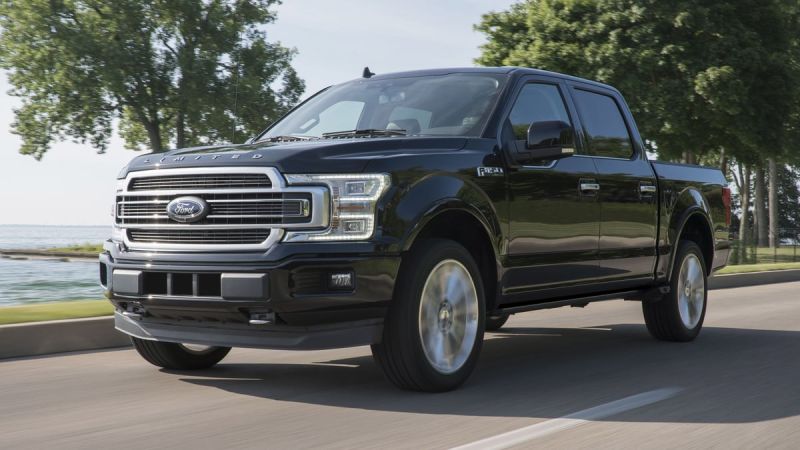I don’t know if you have noticed this but does it seem to you that there are all kinds of information about trailering; how to drive a trailer; trailering for first-time pickup users; and on and on. However, if you switch over to say, loading a pickup for over-the-road travel by a family, you find precious little information.
Loading Your Ford F-150: Important Or Is It?
It’s true! Google the term “loading a Ford F150 Limited properly for a long trip?” What were your results? If Google runs true to form – which it does, it doesn’t know any better – you will get back more than 3.3 million hits, most, if not all of them, dealing with trailering. The topics range from how to set up your pickup to trailer; choosing the right trailer hitch, and other related stories. Will you find a simple story about readying your pickup for a road trip. You may, but, if you do, you will have to spend a long time paging through the 3.3 million results looking for the answer.
Honestly, it is a shame that loading a vehicle properly is given such short-shrift. The why is very easy to state: It’s easier to find information about clipping Pomeranian cats than it is finding out about how to load it. Is loading any the less important? Why is this true? Think about it for a moment. Here, I believe, is most of the answer to this issue: Which makes more money for a dealer or carmaker? Telling people how to load a vehicle or selling the customer a new fifth wheel RV (even the most modern fifth wheel travel trailers can cost well over $40,000 or $50,000, without considering the hitch and other items like load-leveling springs; trailer brakes, and the like.
Watch How Much MPG Do You Lose on Ford F-150 When Hauling Max Load and Click to Subscribe to Torque News Youtube Channel for Daily Ford and Automotive News.
As we discussed recently in another story Payload Plays An Important Part In F150 Handling, paying attention to the payload of your F150 is important. If you go over the limits set for your Ford F150, you run the risk of damaging your pickup (shocks, springs, suspension pieces, tie rod ends, bushings, and bearings, among other things). Also, it upsets the handling so that even if you are super-careful what will happen is that your F150 won’t handle correctly, making it a handful to control through turns and corners.
Loading Your Ford F150: It Pays To Observe The Limits
There is, of course, a way to keep this from happening; observe the payload limits, for starters. And, here are some other thoughts:
- Look at the number of people who will be traveling with you
- Look at the load you will be carrying
- Look at what rides inside your Ford F150
- Look at what rides outside your pickup
- Look at the miscellaneous stuff
The list is pretty easy. You have to wonder why Ford didn’t take a leading position on this minor issue and provide information on how to load your pickup. Let’s face it; if we can pick up on the four or five important issues facing Ford F150 drivers and how to load their pickups, the automaker should be able to do so quite easily.
Loading Your Ford F150: Doing It Right Is Key To Handling
We’ve said this before and will repeat it here: you have to make sure your F150 is loaded properly, or else you risk not only your safety with poor handling. Also, overloading can affect your truck’s tires by stressing them to the point where they tend to run hot (again, not a fantastic idea as it weakens the tires).
A properly loaded Ford F150 will not only track straight, but it will also take curves and turns effortlessly with no surprises. Yes, an F150 is taller than an SUV or crossover, which may have been built on an automobile platform and so is not as stable in all conditions. However, if set up correctly, it is okay most of the time.
Loading Your F150: Passengers Important
One of the bigger variables in loading an F150 is the number of passengers; who they are (children or adults); are they heavyweights or lightweights; where will they ride?
It might seem like an oxymoron taking a look at the passengers in an F150, but it isn’t. As we have already noted Payload Is A Key To Proper F150 Operation., adult men are usually given a body weight of about 180 pounds, while their spouses ( or partners) are about 120. Children, depending on their ages, are usually given a weight of 100 pounds for a boy and 80 pounds for a girl (based on age and muscle mass). Younger kids receive lighter categories like 30 to 60 or 40 to 70 pounds.
So, if you plan to take, say, four small kids – three girls and a boy -- with you, along with your medium-sized pooch, you would figure them at 90, plus 40, and 60 (pooch) or 190 pounds; dad is 180, while mom is 120. That makes your passenger component of the payload 490 pounds. We are using the Ford F150 Limited payload as a gauge (3,250 pounds) that leaves you 2,760 pounds of payload to play with.
Loading Your F150: Let’s Change Parameters
Of course, if there was another adult man, your boy, and pooch, heading out along with you, instead of your wife and the girls, then you will have a payload of 2,580 pounds to play with.
Let’s concentrate on the second case of the equipment load as it is more than likely to be the way you head out for a weekend of camping, off-roading, or biking. In this case, there are a couple of bikes to be stowed (motorized), as well as gasoline and other supplies, plus tools (just in case). Then, there’s the tent or tents that will keep the rain off your head, plus any food that you feel like bringing. And don’t forget the water and drinks for the weekend. The question here is, where do you put everything?
Well, here are our suggestions. First, as you might have guessed, the bikes should be properly stowed, anchored front and rear so that they won’t move around as you motor along.
Loading Your Ford F150: Case For Motorbikes
Since the bikes are motorized, they will likely have gas in their tanks (though we don’t recommend this for any number of safety reasons) so they must be well-secured. Further, you will likely be bringing gasoline, oil, and other items, like tools, a portable compressor, a set of ratchet wrenches, and the like. If you have had bins installed in the bed area, be sure to store your tools and other paraphernalia there, locking them. If thieves were to see your tools in the bed, you can be sure that they will disappear quickly, if you are not watching.
Also, try to distribute the weight so that half is on one side of the bed’s centerline and the other is on the other side. In fact, it might be a good idea to mentally divide the bed into quarters so that each quarter has about the same amount of weight. This will keep the handling truly neutral.
You might be wondering where we are on the payload. With two adult men, your kid, and pooch, you will be at a payload of 2,890 pounds. Now, assuming the pair of bikes back there weigh in at about 100 pounds a piece and each has a full tank, you are looking at 208 pounds for the bikes, and you are now down to 2,572. And, since you are carrying spares and tools for them with the spares taking up about 20 pounds, the payload is down to 2,552. Meanwhile, the gasoline you are carrying for the bikes in two heavy-duty gasoline cans weighs in at 60 pounds (five gallons of fuel in two gasoline cans, each of which weighs, without fuel, roughly 5 pounds. Now, since each gallon weighs roughly five pounds, you have 25 times two or 50 pounds, plus the two five-pound cans). Finally, when you add the gasoline in, you have roughly 2,490 pounds of payload remaining.
And, remember that you will have other items that should be stored in the bed or in bins to store outside such as spare oil and spigots and, of course, fuel. Granted, this isn’t very much, but it will still take you down another 10 pounds or so. Finally, it’s a good idea to throw a tarp or heavy-duty canvas cover over the bikes, in case of rain. Believe it or not, a canvas cover for one of the bikes may weigh as much as 25 more pounds, and if you have two of them back there, your payload now stands at 2,440 pounds. Adding in the spare oils and fuel brings you down to 2,400.
Loading Your Ford F150: Look At What Rides Inside
When it came time to order your Ford F1500 SuperCrew Limited, you should have upfit it -- to upfit is to improve your vehicle; it is trade jargon for adding items of value such as workbenches; storage; security cages, and the like -- with what you will likely find one of your most important additions, under-seat storage. You will find that you can have added storage (besides the standard in-cabin bins and underfloor storage) if you order the proper under-seat storage. You will be glad you did as it keeps things organized and out of the way, while, at the same time, keeping everything very handy to you.
For the most part, the inside storage will be for items like spare clothing; bedding, and personal items that you want to remain as clean as possible. Indeed, you may find it valuable to store another set of tools inside so you can have access to dry tools should it start to rain. Then, there are items like spare sets of boots and sneakers. We won’t go into parsing the storage numbers here as closely as we have done because it is tough to tell what is riding in each storage bin. But, let’s say that each one handles roughly 100 pounds (for the sake of this story), and there are underseat storage units for each of the front seats and two for the longer rear bench area. The two rear storage units, since they are also bigger also can carry more stuff, say 150 pounds. At this point, the payload remaining has dipped to 2,080 pounds. Important personal electronic items should go into the huge storage bin that sits between the front seats.
One thing about the Ford F-150 line is that there’s lots of storage space below the floor in the rear area so if you run out of under seat or bin storage, you can always store other stuff there.
Loading Your Ford F150: Look At Your Miscellaneous Items
There is a whole raft of miscellaneous items that you will either have to or want to carry. For instance, if you will be stopping at an area that features not only back-trail motorbiking but also fishing, you may want to carry a couple of fishing rigs so that you can spend a bit of time with trying to hook “the one that got away,” or the “one that is going to get away.” The storage available beneath the rear bench seat can take care of that. It is also a good spot for lights, radios, even computers, cameras, and the like.
One group of items that will likely head for the backseat area is the food. Be sure that it is as secure as possible as food has been known to fly around the interior of a Ford F150 if it isn't security correctly. Imagine going to an emergency room with an eye injury and when it comes time to tell the nurse how you received it, can you imagine the looks you get when you say chicken leg? One item that you will likely find really helpful is a mobile refrigerator such as the one made by ARB. Drawing as little as one amp, the unit will easily keep your kielbasa at 37-degrees so you won't need to run out for ice at the start of every day as the ARB fridge is on the case.
Among the miscellaneous items to remember practical things such as:
- A first aid kit
- Sunscreen with a high SPF
- Proper clothing
- A battery charger
- Spare phone batteries
- Spare cash
- A shovel or entrenching tool
- Heavy-duty towing cable or rope
- Spare blankets in case it gets cool
- A good set of pots, pans, and a bucket for eating and cleanup
Loading Your F150: Balance Your Pickup
One final thought is balancing your pickup – it’s just that: balance your F150. It doesn’t matter how much stuff you have added to help you give your pickup balanced such as helper springs or coil-over-shocks, better tires and the like. If you don’t bother balancing your pickup, then all of the good stuff you have tried won’t work.
For example, if you carefully balance a pair of motorbikes against the rest of the vehicle, but don’t make sure it all works together, then you haven’t gained very much. In other words, if you can get things to the point where all of the front, rear, and side forces are balanced, but one or other small items remain out of whack, then it doesn’t matter because your F150 will still handle poorly or waste gasoline or something similar. If you remember to get everything right and balanced, then you will find your F150 will handle just about anything you can throw at it.
Please note that all of the figures used in this story are approximations only. We used them to illustrate our points. It is quite possible you will look at the figuring we used to do the work and you may find it quite low or quite high. Whether we used the proper figuring isn’t the case. What is the case is that you have to balance your vehicle no matter the figures used.
You can follow Torque News F150 Reporter Marc Stern on Facebook or Twitter.













Comments
"We are using the Ford F150
Permalink
"We are using the Ford F150 Limited payload as a gauge (3,250 pounds) "...
Uhhh, please don't get people killed. An F150 limited has a payload of about 1400 lbs. Less than half of what you mentioned. If you load it up with 3250 lbs of stuff, that's way way way overloaded.